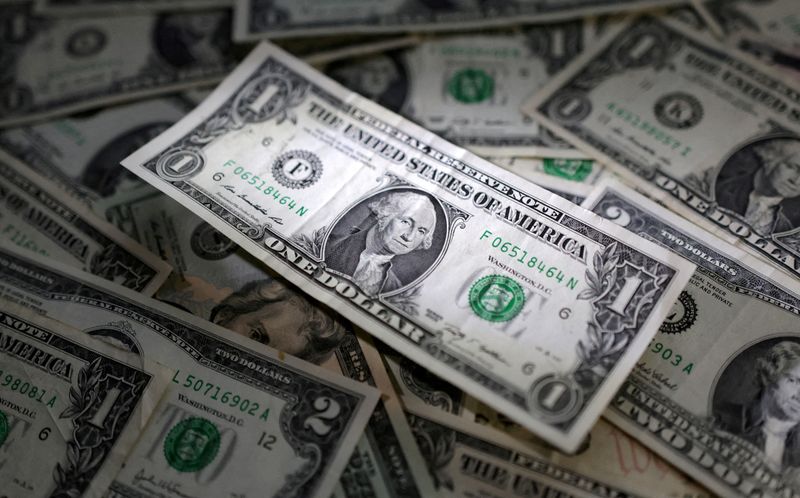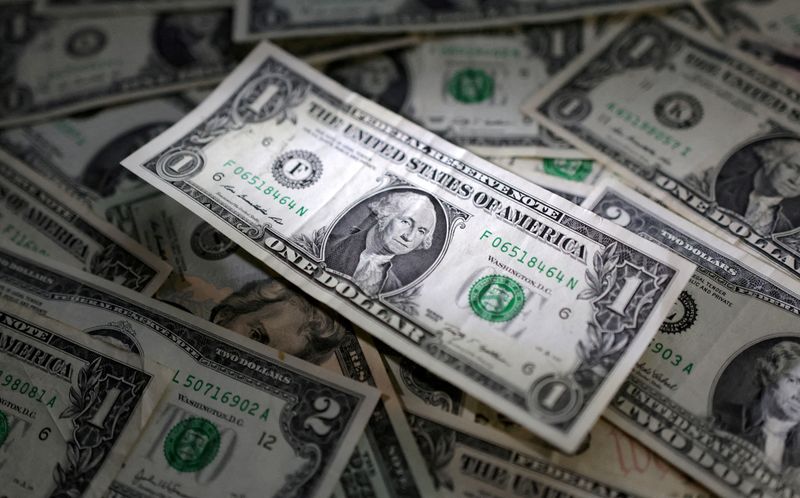
© Reuters. FILE PHOTO: US dollar banknotes are seen in this illustration taken March 10, 2023. REUTERS/Dado Ruvic/Illustration/File Photo
By Saqib Iqbal Ahmed
NEW YORK (Reuters) – The dollar rose against the euro on Friday after weak business data around the world soured risk sentiment and hawkish comments from central banks added pressure on riskier currencies.
US business activity fell to a three-month low in June as growth in services slowed for the first time this year and contraction in the manufacturing sector deepened, data from an observed survey of US companies showed. close on friday.
However, the big picture indicated that US economic growth rose a notch in the second quarter, even as concerns persist that the Federal Reserve’s aggressive interest rate hikes over the past year will trigger a recession. .
Earlier in the session, data showed that business growth in the euro zone had virtually stalled in June. The recession in manufacturing deepened, while activity in the bloc’s dominant services sector barely expanded as overall demand fell for the first time since January.
“We are starting to see signs from companies that demand is starting to taper off at the margin and that is leading to a recalibration of expectations of what future production will look like,” said Bipan Rai, head of Americas FX strategy. del Norte at CIBC Capital Markets. .
“I think concerns about the future outlook are weighing on risk appetite right now and the dollar is picking up a bit from that,” Rai said.
The euro fell 0.57% to $1.08925, a three-day low against the US dollar. The , which measures the currency against six rivals, rose 0.49% to 102.89.
Traders adjusting their books as the end of the month and quarter neared were also likely to support the US currency, Rai said.
Friday’s data came after rate hike surprises and aggressive comments from central banks around the world, which have renewed market fears that policymakers need to go further in tightening policy to control inflation, even at the risk of driving their economies into recession.
“After larger-than-expected rate hikes in the UK and Norway yesterday, markets are nervous about rate hike surprises, and that helped the dollar overnight, even before we saw the PMI data. European currency,” said Kit Juckes, chief currency strategist at Societe Generale. (OTC:) he said in a note.
Fed Chairman Jerome Powell said on Thursday that the central bank would move interest rates at a “careful pace” from now on, but ruled out that interest rate cuts “will happen anytime soon.”
Against the yen, the dollar rose 0.44% to 143.76 yen, its strongest level in more than seven months. The Japanese currency has come under renewed pressure as the Bank of Japan (BOJ) maintains an ultra dovish stance.
Data released on Friday showed Japan’s core consumer inflation topped forecasts in May and an index excluding fuel costs rose at the fastest annual pace in 42 years, putting pressure on the BOJ to phase out its massive stimulus.
The pound was down 0.30% on Friday at $1,271, on pace to end the week down around 1%, its biggest weekly loss in six weeks.
Britain’s currency has come under pressure from rising expectations that the UK economy could slip into recession after the Bank of England posted a wild rate hike on Thursday in response to persistent inflation.
The Australian and New Zealand dollars struggled on Friday as traders avoided riskier currencies.
It fell 1.16% to $0.6678 and was heading for a weekly loss of nearly 3%, its worst week since late August. It slid 0.62% to $0.6139, down about 1.6% for the week.
In cryptocurrency, bitcoin rose 3.46% to a 1-year high of $30,924, on track for a nearly 17% gain on the week, its best weekly gain since mid-March, buoyed by BlackRock’s (NYSE 🙂 to create a bitcoin Mutual Fund.



Be First to Comment